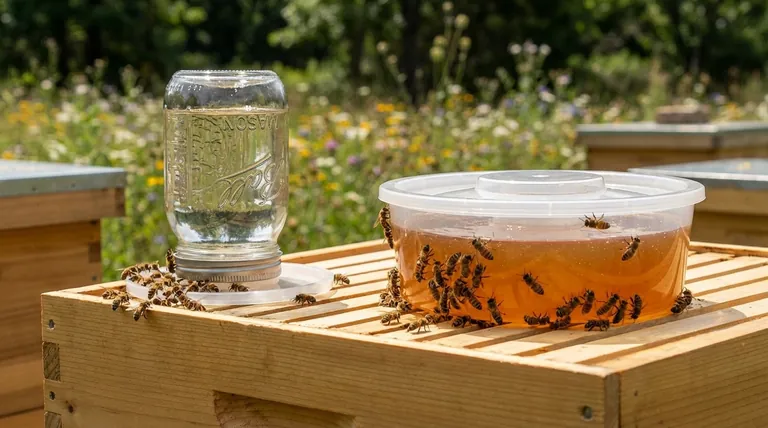The right bee feeder depends entirely on your goal and the season. For spring, you should use a slow, dripping feeder (like a mason jar with small holes in the lid) with a thin 1:1 sugar-to-water syrup. For fall, a rapid feeder that allows many bees to feed at once is best for providing large quantities of heavy 2:1 syrup for winter stores.
Choosing a bee feeder is not about the equipment itself, but about matching the feeding rate and syrup concentration to the colony's seasonal needs—either slow stimulation for spring growth or rapid stockpiling for winter.

The Two Core Goals of Feeding
Feeding sugar syrup is a strategic management tool. Your reason for feeding dictates the type of syrup you use and the equipment required to deliver it.
Stimulative Feeding (Spring)
In early spring, the goal is to mimic a natural nectar flow. This encourages the queen to begin laying eggs and provides the resources for worker bees to build out new wax comb.
This requires a thin 1:1 syrup (equal parts sugar and water by weight), which closely resembles the consistency of natural nectar.
Bulk Feeding (Fall)
In the fall, the goal is entirely different. You need to help the colony quickly build up its food reserves to survive the winter.
This requires a heavy 2:1 syrup (two parts sugar to one part water by weight). The lower water content means the bees expend less energy evaporating it before capping it in the comb for storage.
Matching the Feeder to the Goal
The feeder's design controls how quickly the bees can consume the syrup. This delivery speed is critical for achieving your desired outcome.
Slow Feeders for Spring Stimulation
A slow or "dripping" feeder is ideal for spring. A common example is an inverted jar with a few small holes punched in the lid, placed either directly on the inner cover or at the hive entrance (a Boardman feeder).
This slow, steady supply encourages colony activity without overwhelming them. It prevents the bees from rapidly storing the syrup in the brood nest, which would leave the queen with no room to lay.
Rapid Feeders for Fall Stockpiling
A rapid feeder is designed to hold a large volume of syrup and allow thousands of bees to access it simultaneously. Top hive feeders and in-hive frame feeders are common types.
This design is essential in the fall when the objective is to get as much heavy syrup into the hive as quickly as possible before the weather turns cold.
Common Pitfalls to Avoid
Improper feeding can create more problems than it solves. Understanding the risks is key to supporting your hive effectively.
The Risk of Hive Robbing
The scent of sugar syrup can attract bees from other colonies, leading to a "robbing" frenzy where the stronger hive attacks and steals the resources of the weaker one.
To prevent this, always place feeders inside the hive and refill them in the late evening. This minimizes the scent that escapes and ensures most foraging bees have returned to their own hives for the night.
Blocking the Brood Nest
Using a rapid feeder in the spring is a common mistake. The bees will treat the abundant syrup like a massive nectar flow and will quickly fill the brood cells with it.
This leaves the queen with nowhere to lay, effectively shutting down brood production and defeating the entire purpose of stimulative feeding.
Making the Right Choice for Your Goal
- If your primary focus is stimulating spring growth: Use a slow, dripping feeder with a thin 1:1 syrup to encourage the queen without clogging the brood nest.
- If your primary focus is preparing the hive for winter: Use a large-capacity rapid feeder with a heavy 2:1 syrup to help the colony quickly build its winter stores.
- If your primary focus is preventing hive robbing: Always place feeders inside the hive and refill them in the evening to minimize activity that attracts bees from other colonies.
By aligning your feeding method with the colony's seasonal needs, you transition from simply providing food to strategically managing hive health and productivity.
Summary Table:
| Goal | Season | Syrup Ratio | Feeder Type | Key Benefit |
|---|---|---|---|---|
| Stimulative Feeding | Spring | 1:1 (Sugar:Water) | Slow/Dripping Feeder | Encourages brood production without blocking the brood nest |
| Bulk Feeding | Fall | 2:1 (Sugar:Water) | Rapid/High-Capacity Feeder | Quickly builds winter food stores |
Upgrade Your Apiary's Feeding Efficiency with HONESTBEE
Strategic feeding is key to hive health and honey production. Whether you're a commercial apiary managing hundreds of hives or a distributor supplying beekeepers, having the right feeders for each season is non-negotiable.
HONESTBEE supplies the durable, purpose-built feeders and equipment that professional operations rely on. Our wholesale-focused operations ensure you get the volume and quality needed to support your feeding strategies season after season.
Let's discuss your specific needs:
Contact our expert team today to get the right feeders for your spring stimulation and fall stockpiling goals.
Visual Guide

Related Products
- Rapid Bee Feeder White Plastic 2L Round Top Feeder for 8 or 10-Frame Bee Hives
- HONESTBEE Round Hive Top Bee Feeder for Syrup
- Classic Boardman Entrance Bee Feeder Hive Front Feeding Solution
- HONESTBEE Entrance Bee Feeder Professional Hive Nutrition Solution for Beekeeping
- HONESTBEE Professional Hive Top Bee Feeder Feeding Solution
People Also Ask
- Can you dilute honey and feed it to the bees? Understand the Critical Risks and Safe Practices
- How do you set up and use a top feeder for bees? A Step-by-Step Guide for Safe Feeding
- Can sugar syrup contaminate the honey crop? A Beekeeper's Guide to Protecting Honey Purity
- Do beekeepers leave honey for bees? The Essential Guide to Sustainable Hive Management
- What can the round hive top feeder be used for? A Guide to Efficient, Safe Bee Feeding



















